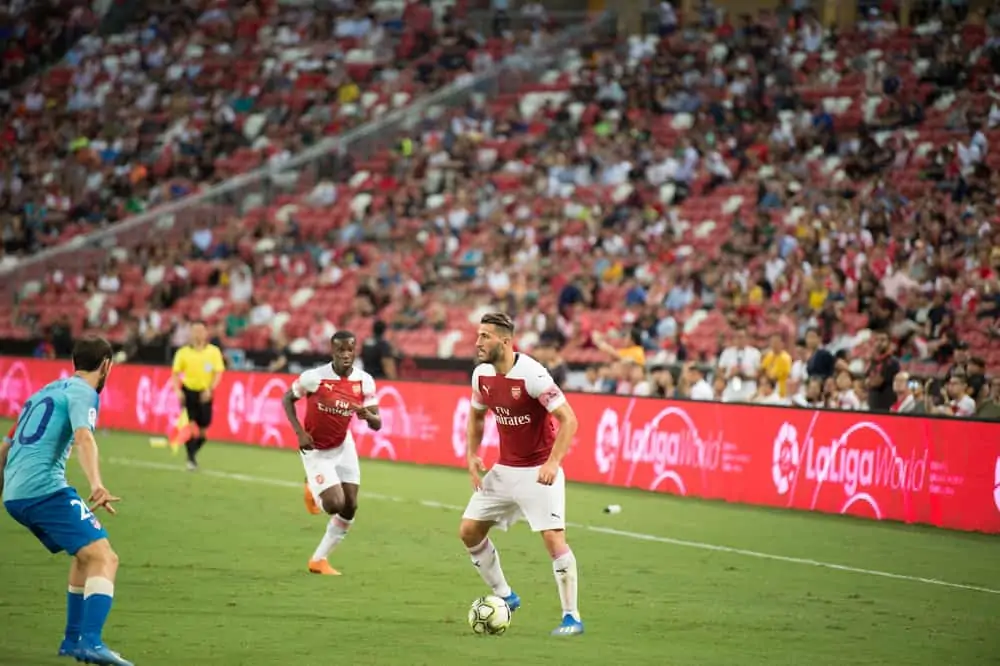Share the post "Why Can’t You Say Mine In Soccer? (Leave It!)"
In the game of soccer, like any sport, players can and can’t do a host of things. What to say is one of them.
In this article, we will go through several things to cover what players can and can’t do. These include:
- Why can’t you say mine in soccer?
- What is forbidden to do in soccer?
- Is it a foul to shout mine in soccer?
- Can you say man on in soccer?
- Is it a foul to shout in soccer?
If you want to understand further what you can and can’t do during a game of soccer then read on.

Why can’t you say mine in soccer?
As stated in the laws of the game, if a soccer player is the only player near the soccer ball and proceeds to call “mine” then there is no foul or infringement.
However, players will only be impeded when the opponent prevents another player from getting and playing with the soccer ball.
But by putting themselves in between the ball and not near the ball and ‘calling mine’, then a foul can be called.
Is it a foul to shout mine in soccer?
In short no, however, if a soccer player shouts mine and verbally distracts the opposition player and stops them from going for the ball then the referee can call a foul and award an indirect free kick.
If a player uses language such as mine, I got it or leave it, and it prohibits an opposing player from going for the ball.
Then the referee can then either give the player a warning or book them with a showing a yellow card.

Can you say man on in soccer?
Generally speaking, you can say “man on” during a soccer game. This is done to warn your teammates that an opposing player is close enough to challenge them and/or take the ball of them.
The term “man on” is not the only phrase that players use instead some players say “Time”.
What this refers to is that the player with the ball has time to dribble and has time to keep their head up and look for a pass to another teammate.
Both terms are equally as effective during a game and in fact, it is just a matter of what certain players prefer.
Is it a foul to shout in soccer?
In short, the answer is no. However, if a fan does use a racist term or a derogatory comment about another player then that fan can be kicked out of the stadium, but it is not a foul.
When a player is fouled, a fan will usually shout and yell that a foul has been committed and that is allowed. Players will often yell and shout when a teammate is fouled or tackled viciously.
This is to alert the match official that a foul has been committed. It is not an uncommon occurrence for players to yell and shout during a game and it is not considered a foul.

What is forbidden to do in soccer?
Players are not allowed to do a host of actions during a match. These include:
- Kicking an opponent
- Tripping
- Jumping into an opponent (for headers etc)
For a soccer game to be played in the right spirit, the referee can blow his whistle to call a foul. Depending on the offense, the referee will show either a yellow or red card.
For small offenses, the referee will blow for a foul and then be awarded an indirect free-kick.
When it is a more serious indiscretion a direct free kick is awarded and if the offense happens inside the penalty box, a penalty is given.
Yellow cards
Yellow cards are branded for a host of reasons. These include when;
- a player repeatedly fouls
- a poor challenge/tackle
- excessive force to another player
- kicking the ball away when a free kick has been awarded
- for referee dissent.
Another way a yellow card can be given is for time-wasting.
Red cards
There are two ways that a player can get a red card in the game of soccer. The first one is when the player commits two fouls that require the referee to brandish a yellow card for each offense.
So, a player who is on a yellow card commits another foul, the referee will then show another yellow card and this will result in a red card being shown.
When this happens, the responsible player will have to leave the field of play for the remainder of the game.
‘Last Man’
Another way a player can be given a red card is that a foul is committed when the fouling player is deemed the last man between the goalkeeper and the ball.
The other one is a player is deemed to have made a reckless challenge with high studs that can cause serious harm to another player.
A red card is shown when a player is deemed to have committed a serious foul or produced violent actions towards another player or even referee.
Denying a Scoring Chance
Also, suppose a player tackles an opposing player inside the penalty box and is deemed by the referee to have denied a clear goalscoring opportunity. In that case, a red card will be shown for the offending player.
Lastly, should a player use his/her hands to stop a goal when they are an outfield player and not a goalkeeper, the referee will brandish a red card for denying a clear goalscoring opportunity.
Sources:
Share the post "Why Can’t You Say Mine In Soccer? (Leave It!)"
Joel is a seasoned soccer journalist and analyst with many years of experience in the field. Joel specializes in game analysis, player profiles, transfer news, and has a keen eye for the tactical nuances of the game. He played at various levels in the game and coached teams - he is happy to share his insight with you.



